Input interpretation

CH_3CH_3 ethane ⟶ H_2 hydrogen + CH_2=CH_2 ethylene
Balanced equation
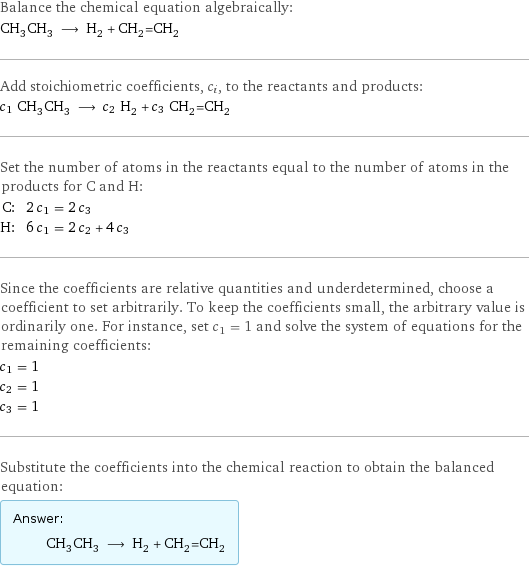
Balance the chemical equation algebraically: CH_3CH_3 ⟶ H_2 + CH_2=CH_2 Add stoichiometric coefficients, c_i, to the reactants and products: c_1 CH_3CH_3 ⟶ c_2 H_2 + c_3 CH_2=CH_2 Set the number of atoms in the reactants equal to the number of atoms in the products for C and H: C: | 2 c_1 = 2 c_3 H: | 6 c_1 = 2 c_2 + 4 c_3 Since the coefficients are relative quantities and underdetermined, choose a coefficient to set arbitrarily. To keep the coefficients small, the arbitrary value is ordinarily one. For instance, set c_1 = 1 and solve the system of equations for the remaining coefficients: c_1 = 1 c_2 = 1 c_3 = 1 Substitute the coefficients into the chemical reaction to obtain the balanced equation: Answer: | | CH_3CH_3 ⟶ H_2 + CH_2=CH_2
Structures

⟶ +
Names

ethane ⟶ hydrogen + ethylene
Reaction thermodynamics
Enthalpy
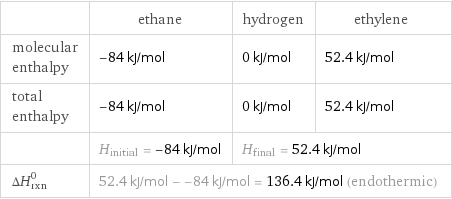
| ethane | hydrogen | ethylene molecular enthalpy | -84 kJ/mol | 0 kJ/mol | 52.4 kJ/mol total enthalpy | -84 kJ/mol | 0 kJ/mol | 52.4 kJ/mol | H_initial = -84 kJ/mol | H_final = 52.4 kJ/mol | ΔH_rxn^0 | 52.4 kJ/mol - -84 kJ/mol = 136.4 kJ/mol (endothermic) | |
Gibbs free energy
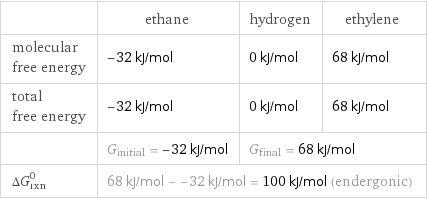
| ethane | hydrogen | ethylene molecular free energy | -32 kJ/mol | 0 kJ/mol | 68 kJ/mol total free energy | -32 kJ/mol | 0 kJ/mol | 68 kJ/mol | G_initial = -32 kJ/mol | G_final = 68 kJ/mol | ΔG_rxn^0 | 68 kJ/mol - -32 kJ/mol = 100 kJ/mol (endergonic) | |
Entropy

| ethane | hydrogen | ethylene molecular entropy | 229.5 J/(mol K) | 115 J/(mol K) | 219 J/(mol K) total entropy | 229.5 J/(mol K) | 115 J/(mol K) | 219 J/(mol K) | S_initial = 229.5 J/(mol K) | S_final = 334 J/(mol K) | ΔS_rxn^0 | 334 J/(mol K) - 229.5 J/(mol K) = 104.5 J/(mol K) (endoentropic) | |
Equilibrium constant
![Construct the equilibrium constant, K, expression for: CH_3CH_3 ⟶ H_2 + CH_2=CH_2 Plan: • Balance the chemical equation. • Determine the stoichiometric numbers. • Assemble the activity expression for each chemical species. • Use the activity expressions to build the equilibrium constant expression. Write the balanced chemical equation: CH_3CH_3 ⟶ H_2 + CH_2=CH_2 Assign stoichiometric numbers, ν_i, using the stoichiometric coefficients, c_i, from the balanced chemical equation in the following manner: ν_i = -c_i for reactants and ν_i = c_i for products: chemical species | c_i | ν_i CH_3CH_3 | 1 | -1 H_2 | 1 | 1 CH_2=CH_2 | 1 | 1 Assemble the activity expressions accounting for the state of matter and ν_i: chemical species | c_i | ν_i | activity expression CH_3CH_3 | 1 | -1 | ([CH3CH3])^(-1) H_2 | 1 | 1 | [H2] CH_2=CH_2 | 1 | 1 | [CH2=CH2] The equilibrium constant symbol in the concentration basis is: K_c Mulitply the activity expressions to arrive at the K_c expression: Answer: | | K_c = ([CH3CH3])^(-1) [H2] [CH2=CH2] = ([H2] [CH2=CH2])/([CH3CH3])](../image_source/a61fc20ba93bc1453ac8b1effe4b5052.png)
Construct the equilibrium constant, K, expression for: CH_3CH_3 ⟶ H_2 + CH_2=CH_2 Plan: • Balance the chemical equation. • Determine the stoichiometric numbers. • Assemble the activity expression for each chemical species. • Use the activity expressions to build the equilibrium constant expression. Write the balanced chemical equation: CH_3CH_3 ⟶ H_2 + CH_2=CH_2 Assign stoichiometric numbers, ν_i, using the stoichiometric coefficients, c_i, from the balanced chemical equation in the following manner: ν_i = -c_i for reactants and ν_i = c_i for products: chemical species | c_i | ν_i CH_3CH_3 | 1 | -1 H_2 | 1 | 1 CH_2=CH_2 | 1 | 1 Assemble the activity expressions accounting for the state of matter and ν_i: chemical species | c_i | ν_i | activity expression CH_3CH_3 | 1 | -1 | ([CH3CH3])^(-1) H_2 | 1 | 1 | [H2] CH_2=CH_2 | 1 | 1 | [CH2=CH2] The equilibrium constant symbol in the concentration basis is: K_c Mulitply the activity expressions to arrive at the K_c expression: Answer: | | K_c = ([CH3CH3])^(-1) [H2] [CH2=CH2] = ([H2] [CH2=CH2])/([CH3CH3])
Rate of reaction
![Construct the rate of reaction expression for: CH_3CH_3 ⟶ H_2 + CH_2=CH_2 Plan: • Balance the chemical equation. • Determine the stoichiometric numbers. • Assemble the rate term for each chemical species. • Write the rate of reaction expression. Write the balanced chemical equation: CH_3CH_3 ⟶ H_2 + CH_2=CH_2 Assign stoichiometric numbers, ν_i, using the stoichiometric coefficients, c_i, from the balanced chemical equation in the following manner: ν_i = -c_i for reactants and ν_i = c_i for products: chemical species | c_i | ν_i CH_3CH_3 | 1 | -1 H_2 | 1 | 1 CH_2=CH_2 | 1 | 1 The rate term for each chemical species, B_i, is 1/ν_i(Δ[B_i])/(Δt) where [B_i] is the amount concentration and t is time: chemical species | c_i | ν_i | rate term CH_3CH_3 | 1 | -1 | -(Δ[CH3CH3])/(Δt) H_2 | 1 | 1 | (Δ[H2])/(Δt) CH_2=CH_2 | 1 | 1 | (Δ[CH2=CH2])/(Δt) (for infinitesimal rate of change, replace Δ with d) Set the rate terms equal to each other to arrive at the rate expression: Answer: | | rate = -(Δ[CH3CH3])/(Δt) = (Δ[H2])/(Δt) = (Δ[CH2=CH2])/(Δt) (assuming constant volume and no accumulation of intermediates or side products)](../image_source/bc4308cd113dbcd9ed7b6447499e344d.png)
Construct the rate of reaction expression for: CH_3CH_3 ⟶ H_2 + CH_2=CH_2 Plan: • Balance the chemical equation. • Determine the stoichiometric numbers. • Assemble the rate term for each chemical species. • Write the rate of reaction expression. Write the balanced chemical equation: CH_3CH_3 ⟶ H_2 + CH_2=CH_2 Assign stoichiometric numbers, ν_i, using the stoichiometric coefficients, c_i, from the balanced chemical equation in the following manner: ν_i = -c_i for reactants and ν_i = c_i for products: chemical species | c_i | ν_i CH_3CH_3 | 1 | -1 H_2 | 1 | 1 CH_2=CH_2 | 1 | 1 The rate term for each chemical species, B_i, is 1/ν_i(Δ[B_i])/(Δt) where [B_i] is the amount concentration and t is time: chemical species | c_i | ν_i | rate term CH_3CH_3 | 1 | -1 | -(Δ[CH3CH3])/(Δt) H_2 | 1 | 1 | (Δ[H2])/(Δt) CH_2=CH_2 | 1 | 1 | (Δ[CH2=CH2])/(Δt) (for infinitesimal rate of change, replace Δ with d) Set the rate terms equal to each other to arrive at the rate expression: Answer: | | rate = -(Δ[CH3CH3])/(Δt) = (Δ[H2])/(Δt) = (Δ[CH2=CH2])/(Δt) (assuming constant volume and no accumulation of intermediates or side products)
Chemical names and formulas
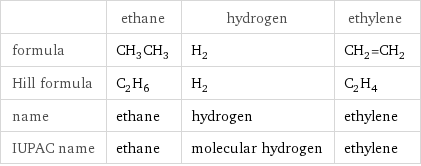
| ethane | hydrogen | ethylene formula | CH_3CH_3 | H_2 | CH_2=CH_2 Hill formula | C_2H_6 | H_2 | C_2H_4 name | ethane | hydrogen | ethylene IUPAC name | ethane | molecular hydrogen | ethylene
Substance properties
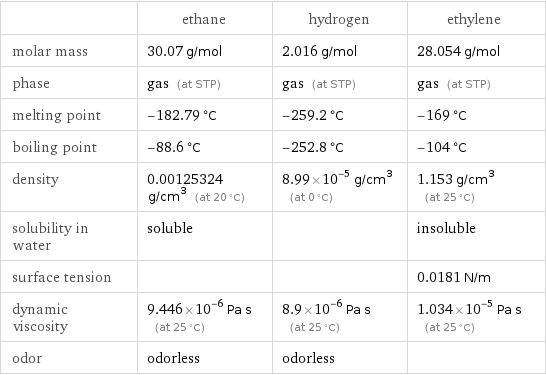
| ethane | hydrogen | ethylene molar mass | 30.07 g/mol | 2.016 g/mol | 28.054 g/mol phase | gas (at STP) | gas (at STP) | gas (at STP) melting point | -182.79 °C | -259.2 °C | -169 °C boiling point | -88.6 °C | -252.8 °C | -104 °C density | 0.00125324 g/cm^3 (at 20 °C) | 8.99×10^-5 g/cm^3 (at 0 °C) | 1.153 g/cm^3 (at 25 °C) solubility in water | soluble | | insoluble surface tension | | | 0.0181 N/m dynamic viscosity | 9.446×10^-6 Pa s (at 25 °C) | 8.9×10^-6 Pa s (at 25 °C) | 1.034×10^-5 Pa s (at 25 °C) odor | odorless | odorless |
Units
